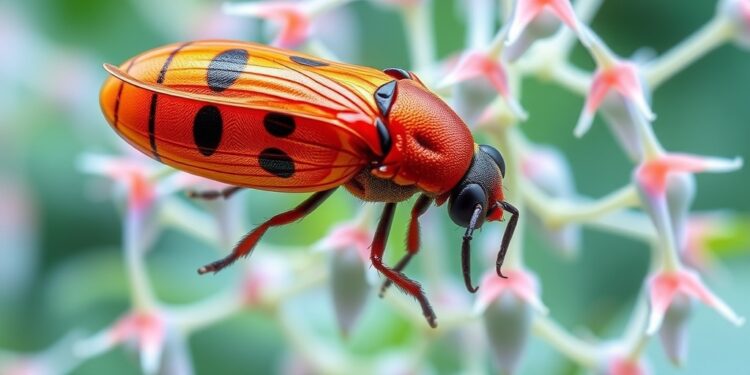
Scientists have made groundbreaking findings about the complex interactions between parasites, plants, and insect vectors, unveiling how a specific bacterial effector can manipulate these dynamics to enhance both its transmission and survival. The study, recently published in eLife, reveals how a protein found in a parasitic bacteria, known as SAP54, alters plant responses in ways that increase the attractiveness of the leafhopper, its insect host, significantly impacting both plant and insect life cycles.
At the center of this investigation is the ineffable relationship that exists within ecosystems involving obligate parasites. These organisms, particularly phytoplasmas, cannot thrive without their hosts, which in this case are sap-feeding insects, notably leafhoppers. The research sheds light on how these pathogens utilize intricate biological mechanisms to ensure that their life cycle aligns closely with that of their insect vectors. By studying the effects of SAP54, the research team uncovered a previously hidden layer to the relationships within plant-bacteria-insect interactions.
Thus far, it has been established that phytoplasmas can induce unusual plant growth, including the formation of peculiar leaf-like flowers, which are instrumental in attracting their insect vectors. These changes are driven by effector molecules; SAP54 is identified as a key virulence protein that triggers these plant modifications. Researchers had previously concluded that leafhopper attraction to these altered plants was significant, yet the underlying mechanisms remained unclear, prompting further exploration into the behaviors and preferences of these insects.
The research led by Zigmunds Orlovskis aimed to elucidate the specific components involved in the attraction of leafhoppers to plants harboring phytoplasmas. By conducting robust choice tests, the team sought to determine the differential responses of male and female leafhoppers to transgenic plants expressing SAP54. The results were striking: the female leafhoppers displayed heightened reproductive success and feeding behavior on SAP54-expressing plants, but only in the presence of their male counterparts. This critical finding indicates that male leafhoppers play an essential role in female attraction to infected plants.
Intriguingly, the study showed that female leafhoppers produced a higher quantity of honeydew—a sweet excretion often indicative of feeding behavior—on SAP54 plants when males were present. Conversely, when males were absent, the female leafhoppers exhibited no such increase, further emphasizing the necessity of male leafhoppers in guiding female choices regarding egg-laying sites. This male-dependent behavior hints at a complex interplay between genders within this insect species, intricately choreographed by the bacterial effector.
To decipher the specific signals that lead to increased female preference for plants infested with male leafhoppers, the research team conducted controlled experiments removed from the influence of external stimuli such as odors and sounds. The absence of behavioral changes in female leafhoppers during these tests indicated that traditional sensory cues were not at play. This necessitated a closer inspection of the biochemical pathways activated within the infected plants, leading them to hypothesize a unique genetic response induced by male leafhopper presence.
The team investigated gene activity differences between SAP54-containing and control plants by monitoring the reactions of the host to both male and female leafhoppers. Their analysis revealed a pronounced alteration in gene expression patterns correlating with male presence, particularly within genes related to biotic stress and cellular defense mechanisms. In the presence of male leafhoppers, the plant’s response pathways exhibited significant downregulation, potentially creating a more favorable environment for female leafhoppers.
The scientists’ initial hypothesis regarding MADS-box transcription factors (MTFs) and their role in leafhopper preference directed them to further choice tests focused on plants genetically modified to lack specific MTFs. Notably, the research established that a particular MTF known as SHORT VEGETATIVE PHASE (SVP) was crucial in the female preference for male-exposed SAP54 plants. The findings demonstrated how plants without SVP responded differently to male and female leafhoppers, showcasing the nuanced relationships influenced by gender-specific behaviors in the insect kingdom.
The implications of this research extend beyond mere biological curiosity. The manipulation of plant responses by the phytoplasmal effector SAP54 effectively makes the affected plants act as a biological matchmaking service. This intriguing aspect raises significant questions about the evolutionary aspects of plant-insect interactions and highlights the fascinating strategies employed by parasites to ensure their propagation through the transmission dynamics facilitated by their vectors.
Moreover, Saskia Hogenhout, the senior author of the study, emphasized the broader ramifications of this work in understanding how one simple parasite gene can significantly influence not only host biology but also the behaviors of its insect vectors. By shaping the ecology of these interactions, the phytoplasma’s survival strategy is finely tuned to optimize transmission rates, thereby securing its place within the ecosystem.
Overall, the study underscores the importance of examining the multilayered relationships in nature where parasites, plants, and insects converge. The detailed molecular interactions showcased in this research provide vital insights that could have far-reaching implications for agricultural practices, pest management, and understanding disease transmission mechanisms in crops, which are often affected by phytoplasmas and their insect vectors.
These findings highlight the necessity for continued research into plant-pathogen interactions and insect behavior, as understanding these dynamics can lead to innovative strategies for managing crop health and mitigating the detrimental impacts of pest-related diseases. As science delves deeper into these intricate ecological webs, the results promise to unveil more surprising revelations about the interconnected lives of microorganisms, plants, and animals.
In conclusion, the research marks an essential step toward comprehending the biochemical dance between phytoplasmas, plants, and leafhoppers. With each discovery, a clearer picture emerges of how such organisms have adapted over time to negotiate the complexities of life, survival, and reproduction, thus enriching our understanding of ecological interactions at both micro and macro levels.
Subject of Research: The role of the phytoplasma effector SAP54 in influencing leafhopper attraction to plants
Article Title: The phytoplasma SAP54 effector acts as a molecular matchmaker for leafhopper vectors by targeting plant MADS-box factor SVP
News Publication Date: 7-Jan-2025
Web References: eLife
References: DOI Link
Image Credits: Not available
Keywords: Phytoplasmas, leafhoppers, SAP54, plant-insect interactions, MADS-box transcription factors, virulence proteins, ecological interactions, crop health.





